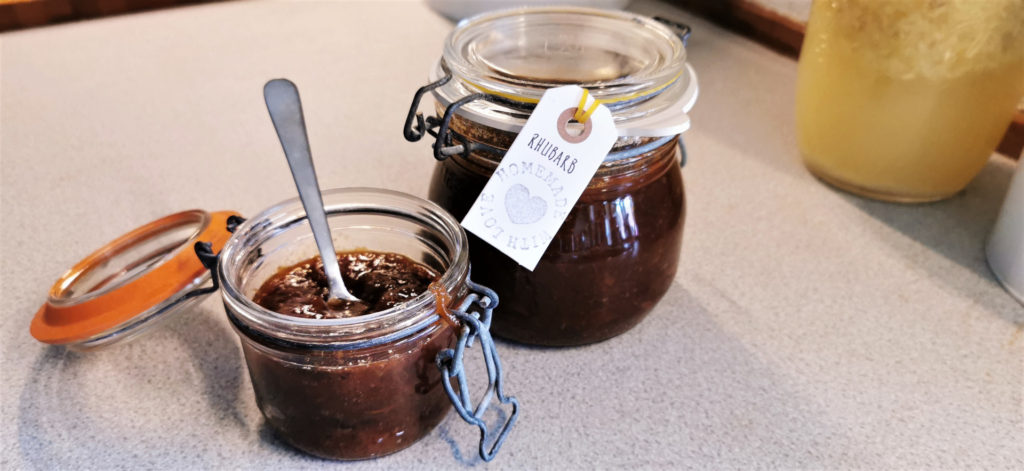So finally, summer is upon us, and that of course means a lot of goodies can be found in the garden. Delicious veggies and berries are slowly coming into season. Rhubarb is one of the earliest harvests here where I live in Denmark. As soon as the temperature rises, even just a little bit, it springs into action. This year my rhubarb plants got even more ambitious, growing big and tall and one of them even flowered. It turns out rhubarb likes the weather a little on the cooler side, which is good because we had a crappy spring. Wet, windy and cold. It was just winter and then suddenly two weeks ago it turned into full blown summer.
General knowledge corner
The botanical name for rhubarb is Rheum rhabarbaranum and it’s a perennial vegetable. It originates from Asia and was brought to Europe in the 1600s. There are a few varieties that are commonly used today such as, ‘Canada Red’, ‘Crimson Red’, and ‘Valentine’. They vary in color and some are redder then others they do not differ in taste.
Rhubarb, and in particular rhubarb jam, is one of those things every Icelandic person I know has some kind of connection to. It was the taste of summer, the only jam your granny used in her baking, etc. It was a staple in every kitchen when I was little because, you know Iceland – it’s cold, so rhubarb feels right at home. So it’s time to make my traditional Icelandic rhubarb jam. The great thing about rhubarb is it’s actually low in calories, only about 21kcal per 100g (3,5 oz), compared to 33 kcal p.100g for strawberries, it’s a good choice when making jam. Not that jam will ever be low kcal, it’s just a little better.
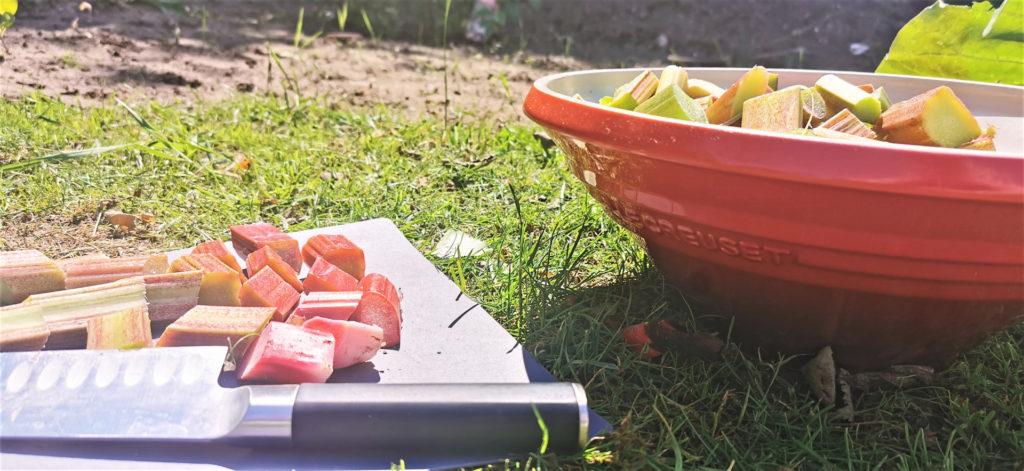
Harvest
The way you do it is to just pick a stem and pull. That’s it. The edible part is the stalk and when raw (you can absolutely eat them raw) it is crunchy, a bit like celery (different family though), and it tastes sour. You can use every part of the stalk, including the green part. The leaves unfortunately are inedible so better just to dump them on the compost heap.
The leaves are poisonous
Because of the oxalic acid content in the leaves they are poisonous so only the stalk is edible. There is oxalic acid in the stalk as well but in much lower concentrations. Oxalic acid can cause vomiting and diarrhea,
so better steer clear of those leaves.
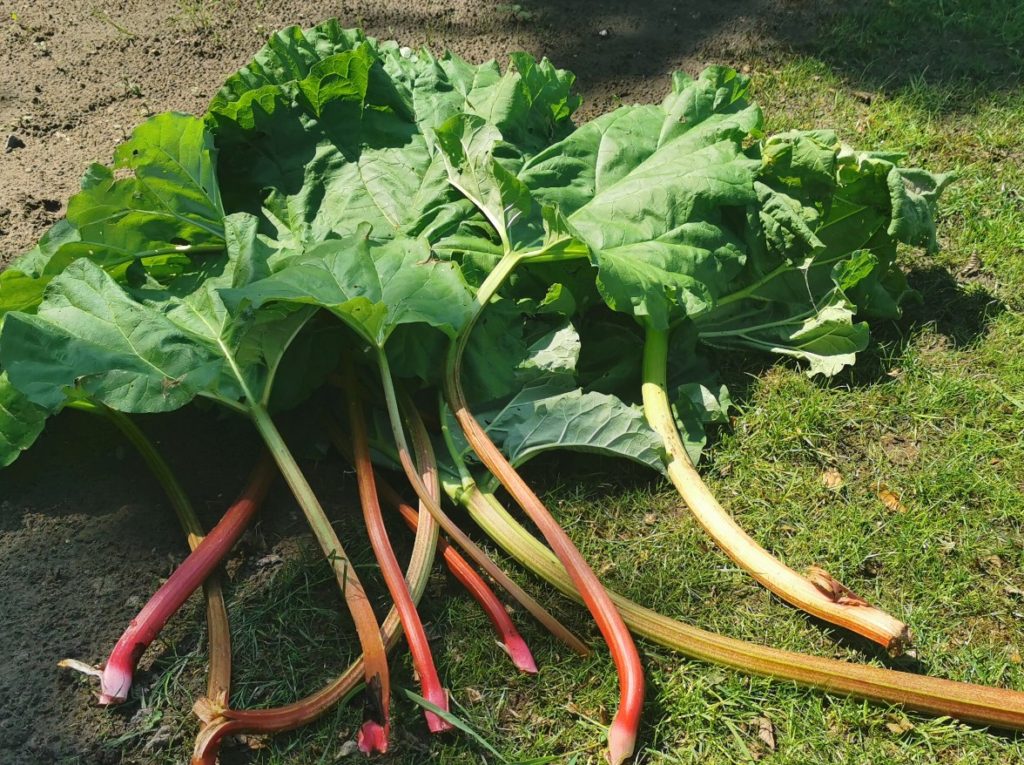
Making rhubarb jam is Easy as pie
Making jam is as easy as pie. I love that saying. Easy as pie. Did you know it has in fact nothing to do with actual pie? It originated in Australia where “pie on” means to be good at something and that phrase comes from an old Mauri word “pai ” which means good. So making jam is gooooood. Well, where were we? Yes, rhubarb.
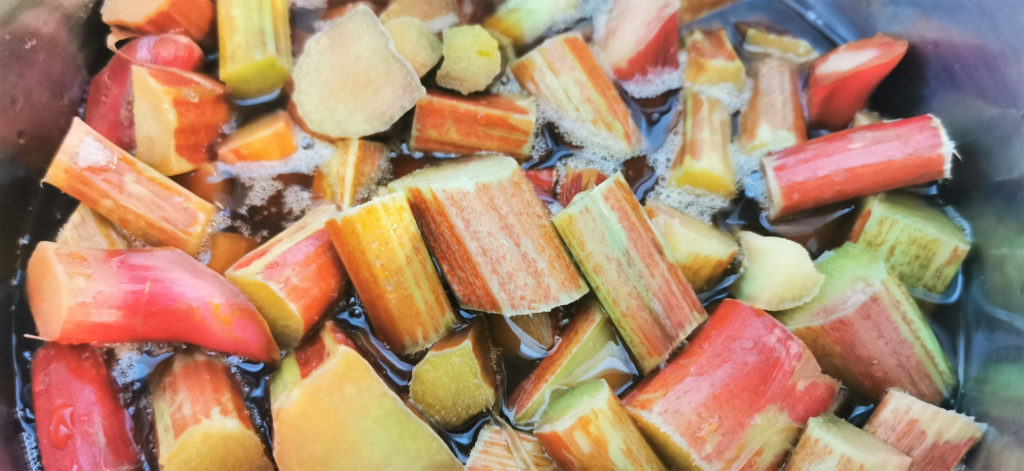
You put the rhubarb and sugar into a thick bottomed pan or pot. Here the pan/pot should be wider rather than high so the jam cooks evenly. Cook the jam in smaller batches rather than overfill the pot. Don’t use aluminum, because this will discolor and turn the rhubarb brown and if you are using a bright red variety you don’t want that. If you are not sure if your pots or pans are aluminum, use a magnet of some kind, i use an ordinary fridge magnet, and if it sticks it is not aluminum and you are good to go.
Sweeteners & Prep
Sugar content and ratios. In the olden days the ratio was one to one, but that was likely so it would keep longer. These days we can harvest our rhubarb and freeze it, to be used whenever the fancy takes us. Just clean the stalks, cut them into chunks and if you have a vacuum sealer use that and if not a freezer bag will do nicely. Into the freezer and you have rhubarb for those rainy days.

There are a variety of sugars you can use, cane sugar, unrefined sugar, brown sugar, caster sugar, and a multitude of others so use what you have and are used to. Now there are a wide variety of condiments and juices you can add to your jam to make it something special. Cinnamon, vanilla, cardamon, lemon, you can even use strawberries or dates and instead use less sugar. Just go wild and make it in small batches so you can experiment. Food making should be fun. My recipe is just the basic rhubarb jam. Rhubarb, sugar and a little salt and that’s it.
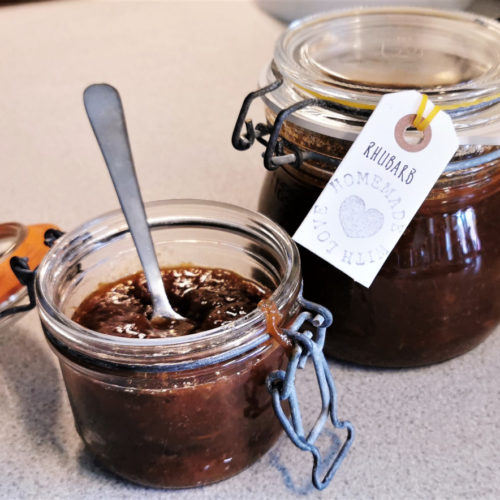
Rhubarb Jam
Equipment
- Large bowl
- Pot or a pan (not aluminum)
- Wooden spoon
- Glass jar
Ingredients
- 700 g rhubarb (1,5 lbs)
- 200 g castor sugar (7 oz)
- 200 g brown sugar (7 oz)
- 1/4 tsp salt
Instructions
- If you just picked your rhubarb you need to clean it and cut it into 2-3 cm (ca 1 inch) bites. I just lightly rinsed mine outside and cut them and then put them into a large bowl, filled it with water and gave them a good stir. All dirt will fall to the bottom. Took them out and laid them out on a clean dish towel to drain a bit, because I wanted to freeze the bulk of them.
- After I discovered that my go-to pot for jam making is aluminum I had to make due with a smaller one. So I adjusted my amounts accordingly just because even heat is the key for easy jam making. So into the pot all the ingredients save for the salt. The lid goes on and then I let the whole thing sit overnight. This will allow the sugar to extract some of the juices from the rhubarb, softening them up, so you don't need to add water in the beginning and it cuts down on the actual cooking time.
- The next day before you start the cooking process you need to choose the jars and sterilize them (or as close as). Take the jar and place it into the oven upside down and heat it up to 160°C (320°F) for 10 minutes. If you use a clip top jar then remember to take the rubber off before you place it in the oven. If you are using a metal lid, put it into boiling water for about a minute before you use them. When you start the oven you are ready to cook the jam.
- Take the pot and put it onto a medium heat, stirring occasionally until it begins to bubble. Then I turn the heat down and let it simmer for about 30 minutes, again stirring occasionally. The rhubarb will start to fall apart after about 15 minutes and then it is just a matter of consistency.
- When the consistency is to your liking, it is time to transfer the jam over to the now sterilized jar. Take care not to burn yourself and try not to touch the inside of the jars. You need them to be as sterile as possible. You could put the jam into a pitcher and pour it in but I just take my time and concentrate, which let’s be honest can be difficult for an ADD person. Leave about 2-3 cm (about an inch) on top and close the jar. Now you have your rhubarb jam.
- This will keep unopened for a long time in a cool and dry place like your cupboard. I would say at least 3-4 months. Just remember that because contamination can happen if we are not careful so if you see mold on top just throw it out. After you open a jar, keep it in the fridge.

